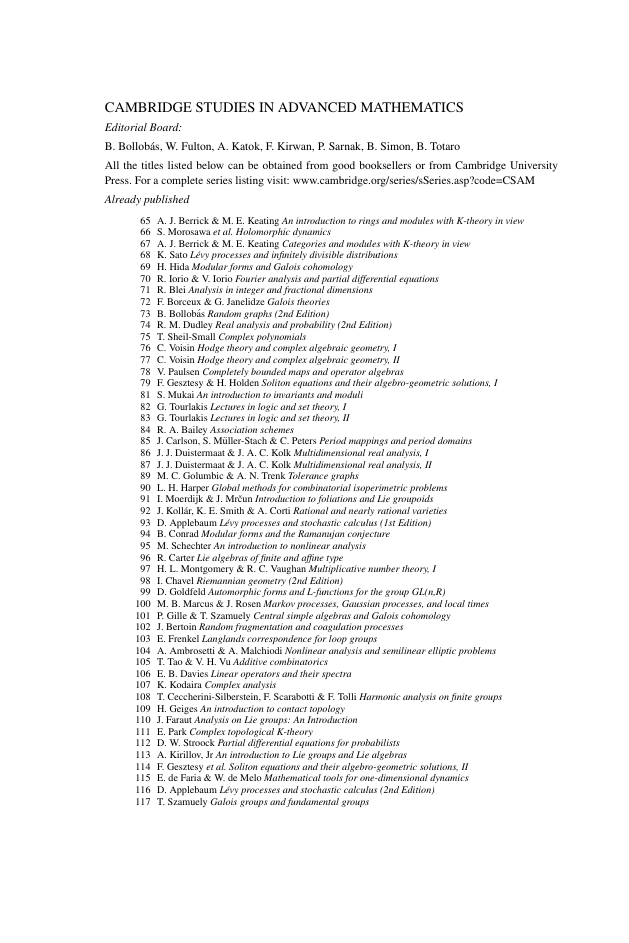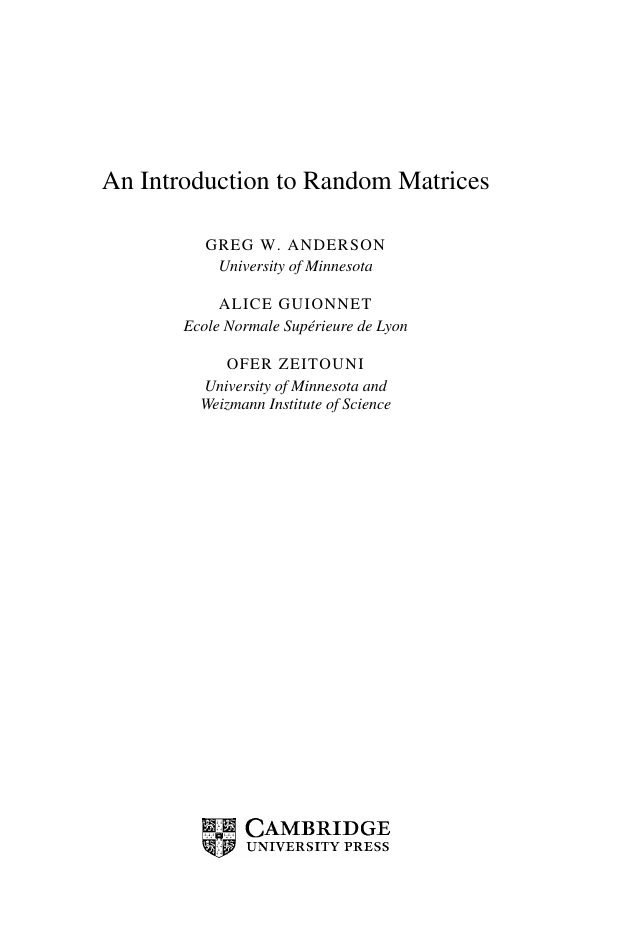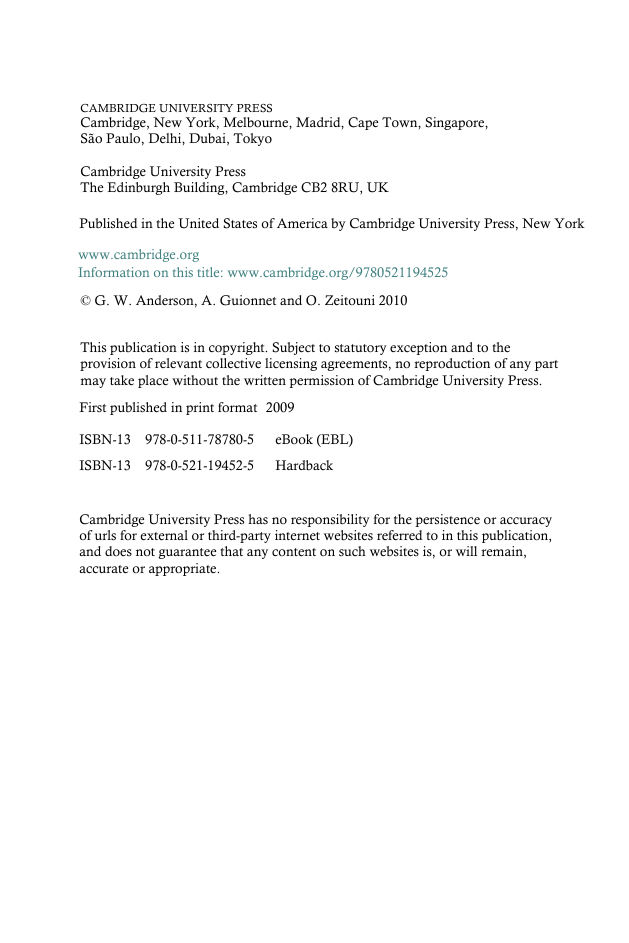Cover
Half-title
Series-title
Title
Copyright
Dedication
Contents
Preface
1 Introduction
2 Real and complex Wigner matrices
2.1 Real Wigner matrices: traces, moments and combinatorics
2.1.1 The semicircle distribution, Catalan numbers and Dyck paths
2.1.2 Proof #1 of Wigner’s Theorem 2.1.1
2.1.3 Proof of Lemma 2.1.6: words and graphs
2.1.4 Proof of Lemma 2.1.7: sentences and graphs
2.1.5 Some useful approximations
2.1.6 Maximal eigenvalues and F¨uredi–Koml´os enumeration
2.1.7 Central limit theorems for moments
2.2 Complex Wigner matrices
2.3 Concentration for functionals of random matrices and logarithmic Sobolev inequalities
2.3.1 Smoothness properties of linear functions of the empirical measure
2.3.2 Concentration inequalities for independent variables satisfying logarithmic Sobolev inequalities
2.3.3 Concentration for Wigner-type matrices
2.4 Stieltjes transforms and recursions
2.4.1 Gaussian Wigner matrices
2.4.2 General Wigner matrices
2.5 Joint distribution of eigenvalues in the GOE and the GUE
2.5.1 Definition and preliminary discussion of the GOE and the GUE
2.5.2 Proof of the joint distribution of eigenvalues
2.5.3 Selberg’s integral formula and proof of (2.5.4)
2.5.4 Joint distribution of eigenvalues: alternative formulation
2.5.5 Superposition and decimation relations
2.6 Large deviations for random matrices
2.6.1 Large deviations for the empirical measure
Exponential tightness
A large deviation upper bound
A large deviation lower bound
2.6.2 Large deviations for the top eigenvalue
2.7 Bibliographical notes
3 Hermite polynomials, spacings and limit distributions for the Gaussian ensembles
3.1 Summary of main results: spacing distributions in the bulk and edge of the spectrum for the Gaussian ensembles
3.1.1 Limit results for the GUE
3.1.2 Generalizations: limit formulas for the GOE and GSE
3.2 Hermite polynomials and the GUE
3.2.1 The GUE and determinantal laws
3.2.2 Properties of the Hermite polynomials and oscillator wave-functions
3.3 The semicircle law revisited
3.3.1 Calculation of moments of LN
3.3.2 The Harer–Zagier recursion and Ledoux’s argument
3.4 Quick introduction to Fredholm determinants
3.4.1 The setting, fundamental estimates and definition of the Fredholm determinant
3.4.2 Definition of the Fredholm adjugant, Fredholm resolvent and a fundamental identity
Multiplicativity of Fredholm determinants
3.5 Gap probabilities at 0 and proof of Theorem 3.1.1
3.5.1 The method of Laplace
3.5.2 Evaluation of the scaling limit: proof of Lemma 3.5.1
3.5.3 A complement: determinantal relations
3.6 Analysis of the sine-kernel
3.6.1 General differentiation formulas
3.6.2 Derivation of the differential equations: proof of Theorem 3.6.1
3.6.3 Reduction to Painlev´e V
3.7 Edge-scaling: proof of Theorem 3.1.4
3.7.1 Vague convergence of the largest eigenvalue: proof of Theorem 3.1.4
3.7.2 Steepest descent: proof of Lemma 3.7.2
3.7.3 Properties of the Airy functions and proof of Lemma 3.7.1
3.8 Analysis of the Tracy–Widom distribution and proof of Theorem 3.1.5
3.8.1 The first standard moves of the game
3.8.2 The wrinkle in the carpet
3.8.3 Linkage to Painlev´e II
3.9 Limiting behavior of the GOE and the GSE
3.9.1 Pfaffians and gap probabilities
Pfaffian integration formulas
Determinant formulas for squared gap probabilities
3.9.2 Fredholm representation of gap probabilities
Matrix kernels and a revision of the Fredholm setup
Main results
3.9.3 Limit calculations
Statements of main results
Proofs of bulk results
3.9.4 Differential equations
Block matrix calculations
Proof of Theorem 3.1.6
Proof of Theorem 3.1.7
3.10 Bibliographical notes
4 Some generalities
4.1 Joint distribution of eigenvalues in the classical matrix ensembles
4.1.1 Integration formulas for classical ensembles
The Gaussian ensembles
Laguerre ensembles and Wishart matrices
Jacobi ensembles and random projectors
The classical compact Lie groups
4.1.2 Manifolds, volume measures and the coarea formula
4.1.3 An integration formula of Weyl type
4.1.4 Applications of Weyl’s formula
4.2 Determinantal point processes
4.2.1 Point processes: basic definitions
4.2.2 Determinantal processes
4.2.3 Determinantal projections
4.2.4 The CLT for determinantal processes
4.2.5 Determinantal processes associated with eigenvalues
The sine process
The Airy process
4.2.6 Translation invariant determinantal processes
4.2.7 One-dimensional translation invariant determinantal processes
4.2.8 Convergence issues
4.2.9 Examples
The biorthogonal ensembles
Birth–death processes conditioned not to intersect
4.3 Stochastic analysis for random matrices
4.3.1 Dyson’s Brownian motion
4.3.2 A dynamical version of Wigner’s Theorem
4.3.3 Dynamical central limit theorems
4.3.4 Large deviation bounds
4.4 Concentration of measure and random matrices
4.4.1 Concentration inequalities for Hermitian matrices with independent entries
Entries satisfying Poincare’s
inequality
Matrices with bounded entries and Talagrand’s method
4.4.2 Concentration inequalities for matrices with dependent entries
The setup with M = Rm and µ=Lebesgue measure
The setup with M a compact Riemannian manifold
Applications to random matrices
4.5 Tridiagonal matrix models and the β ensembles
4.5.1 Tridiagonal representation of β ensembles
4.5.2 Scaling limits at the edge of the spectrum
4.6 Bibliographical notes
5 Free probability
5.1 Introduction and main results
5.2 Noncommutative laws and noncommutative probability spaces
5.2.1 Algebraic noncommutative probability spaces and laws
5.2.2 C-probability spaces and the weak*-topology
C-probability spaces
Weak*-topology
5.2.3 W-probability spaces
Laws of self-adjoint operators
5.3 Free independence
5.3.1 Independence and free independence
5.3.2 Free independence and combinatorics
Basic properties of non-crossing partitions
Free cumulants and freeness
5.3.3 Consequence of free independence: free convolution
Multiplicative free convolution
5.3.4 Free central limit theorem
5.3.5 Freeness for unbounded variables
5.4 Link with random matrices
5.5 Convergence of the operator norm of polynomials of independent GUE matrices
5.6 Bibliographical notes
Appendices
A Linear algebra preliminaries
A.1 Identities and bounds
A.2 Perturbations for normal and Hermitian matrices
A.3 Noncommutative matrix Lp-norms
A.4 Brief review of resultants and discriminants
B Topological preliminaries
B.1 Generalities
B.2 Topological vector spaces and weak topologies
B.3 Banach and Polish spaces
B.4 Some elements of analysis
C Probability measures on Polish spaces
C.1 Generalities
C.2 Weak topology
D Basic notions of large deviations
E The skew field H of quaternions and matrix theory over F
E.1 Matrix terminology over F and factorization theorems
E.2 The spectral theorem and key corollaries
E.3 A specialized result on projectors
E.4 Algebra for curvature computations
F Manifolds
F.1 Manifolds embedded in Euclidean space
“Critical” vocabulary
Lie groups and Haar measure
F.2 Proof of the coarea formula
F.3 Metrics, connections, curvature, Hessians, and the Laplace–Beltrami operator
Curvature of classical compact Lie groups
G Appendix on operator algebras
G.1 Basic definitions
G.2 Spectral properties
G.3 States and positivity
G.4 von Neumann algebras
G.5 Noncommutative functional calculus
H Stochastic calculus notions
References
General conventions and notation
Index
















 2023年江西萍乡中考道德与法治真题及答案.doc
2023年江西萍乡中考道德与法治真题及答案.doc 2012年重庆南川中考生物真题及答案.doc
2012年重庆南川中考生物真题及答案.doc 2013年江西师范大学地理学综合及文艺理论基础考研真题.doc
2013年江西师范大学地理学综合及文艺理论基础考研真题.doc 2020年四川甘孜小升初语文真题及答案I卷.doc
2020年四川甘孜小升初语文真题及答案I卷.doc 2020年注册岩土工程师专业基础考试真题及答案.doc
2020年注册岩土工程师专业基础考试真题及答案.doc 2023-2024学年福建省厦门市九年级上学期数学月考试题及答案.doc
2023-2024学年福建省厦门市九年级上学期数学月考试题及答案.doc 2021-2022学年辽宁省沈阳市大东区九年级上学期语文期末试题及答案.doc
2021-2022学年辽宁省沈阳市大东区九年级上学期语文期末试题及答案.doc 2022-2023学年北京东城区初三第一学期物理期末试卷及答案.doc
2022-2023学年北京东城区初三第一学期物理期末试卷及答案.doc 2018上半年江西教师资格初中地理学科知识与教学能力真题及答案.doc
2018上半年江西教师资格初中地理学科知识与教学能力真题及答案.doc 2012年河北国家公务员申论考试真题及答案-省级.doc
2012年河北国家公务员申论考试真题及答案-省级.doc 2020-2021学年江苏省扬州市江都区邵樊片九年级上学期数学第一次质量检测试题及答案.doc
2020-2021学年江苏省扬州市江都区邵樊片九年级上学期数学第一次质量检测试题及答案.doc 2022下半年黑龙江教师资格证中学综合素质真题及答案.doc
2022下半年黑龙江教师资格证中学综合素质真题及答案.doc